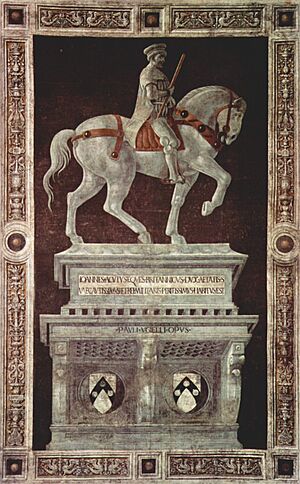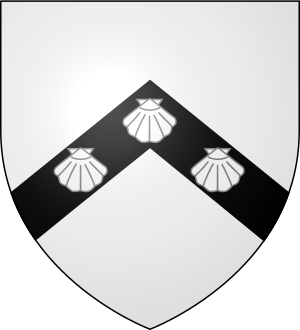John Hawkwood facts for kids

Sir John Hawkwood (born around 1323 – died March 17, 1394) was an English soldier. He became a famous leader of mercenaries, also known as a condottiero, in Italy. Because his name was hard for Italians to say, he was often called Giovanni Acuto. This means "John Sharp" or "John the Astute," showing how clever he was. Many stories and myths grew around him in both England and Italy. Today, he is still well-known because of a large painting of him in the Florence Cathedral, which millions of people see every year.
Contents
Early Life of a Soldier
John Hawkwood was likely born around 1323 in a place called Sible Hedingham in England. He was the second son of Gilbert Hawkwood. Some old stories say he grew up poor, but his father was actually a successful tanner and owned land. This meant his family had a good amount of money. John did not stay home for long. He moved to London to learn the trade of a tailor.
Becoming a Mercenary Leader
Hawkwood started his military career in France during the Hundred Years' War. He fought as a longbowman for King Edward III. He might have fought in famous battles like Crécy (1346) and Poitiers (1356). After these wars, he joined a group of mercenaries called the White Company. These were soldiers who fought for money. In 1361, he traveled with them to Italy and became their captain in 1363.
Even though Hawkwood was called a knight, it's not clear who knighted him or where. In Italy, all important mercenary leaders were seen as knights. Once in Italy, he fought for many different groups, including the Pope, the city of Milan, and the city of Florence. He spent the rest of his life fighting in Italy, ending his career in Florence.
Hawkwood was paid in gold coins called florins, which were common at the time. As a captain for 30 years, he earned a lot of money, sometimes between 6,000 and 80,000 florins a year. To compare, a skilled worker in Florence at that time might earn only 30 florins a year.
Fighting in France
After a peace treaty was signed in 1360, many groups of soldiers, called "free companies," formed. The largest of these was the Great Company, later known as the White Company. Hawkwood joined this group and eventually became its leader. They moved through different parts of France.
In 1360, the company took control of a town called Pont-Saint-Esprit near Avignon. This town was important for collecting taxes. The Pope at the time, Pope Innocent VI, tried to make peace with them, even writing a letter to Hawkwood as their leader. But the company did not listen and kept control of the town. This led to them being kicked out of the church (excommunicated). In 1361, they made a deal with the Pope to fight for him in Spain and Italy. Hawkwood joined the group heading to Italy.
Before reaching Italy, Hawkwood's company joined the Marquis of Montferrat in his war against the Count of Savoy. They won battles and stayed in Savoy for a year. This success led the Marquis to hire them to fight against the powerful Visconti family in Milan.
Serving Italian Cities
Hawkwood arrived in Italy when many different leaders were trying to gain power. His first big job was leading the army of Pisa in a war against Florence in 1364. He was almost 40 years old. In the Battle of Cascina, Hawkwood showed his skill as a military leader, even though his side lost. He carefully studied the land and conditions to position his army well. However, the other side managed to surround part of his army, forcing Hawkwood to order a retreat. Some stories make this battle sound like a heroic stand, but the loss was likely due to his young, less experienced soldiers.
Another important battle for Hawkwood was Rubiera in 1372. He fought for the Visconti family against the Pope's forces. Even though both sides had agreed to a truce, they were secretly gathering more soldiers. Hawkwood had a smaller army, but he used clever moves to outsmart his enemy. He managed to capture many of the opposing officers. This victory showed Hawkwood's great skill as a commander, even though it didn't change much politically and ended in another truce.
One of Hawkwood's most notable actions was a large raid into Tuscany. This event showed how much influence mercenary leaders had on Italian politics. Hawkwood was upset because the Pope wasn't paying him. So, he marched his army towards Tuscany and Florence. Two ambassadors from Tuscany met him and paid him a large sum of 130,000 florins to make a truce. He continued to march through other areas, always asking for money. Many believed these raids were ordered by the Pope. This led Florence and Milan to form a group to defend themselves. Other cities like Siena, Pisa, and Lucca soon joined them against Hawkwood and the Pope. This raid was a main reason for the start of the War of the Eight Saints.
In the War of Eight Saints (1375), Hawkwood first fought for Pope Gregory XI against Florence. He was sent to stop a rebellion in Città di Castello, but he ended up capturing the city himself to get paid by the Pope. Later, he went to Faenza to protect the papal governor. When he wasn't paid, his soldiers took goods from the town. Florence then offered Hawkwood money and forgiveness if he would stop fighting them. But he stayed with the Pope. He also took part in a terrible event in Cesena, where he and his men attacked unarmed people. After this, Hawkwood left the Pope's service and began working with Milan, Florence, and their allies.
Hawkwood eventually signed a contract with Florence after a disagreement with his father-in-law, Bernabò Visconti. Bernabò took away land that Hawkwood had received when he married his daughter. So, Florence hired Hawkwood and his company for what turned out to be a very long time.
Final Years with Florence
By 1385, Hawkwood was over 60 years old. He owned land in both Italy and England. Even though he was a citizen of Florence, he was never allowed to enter the city itself. Most of his work for Florence involved defending their lands. He hadn't fought in a major battle for over ten years.
However, in 1385-1386, a war started between Padua and Verona. The most important battle was the Battle of Castagnaro. This battle is often called Hawkwood's "finest victory" and one of the greatest military achievements of that time. During the battle, Hawkwood saw that the enemy's left side was open. He ordered his men to attack there, which led to a big victory for him and his allies from Padua. Records say that 4,620 enemy soldiers were captured.
Hawkwood's last major military campaign was the war against Milan from 1390-1392. He didn't win new glory, but he did make a very smart and successful retreat while deep in enemy territory. His very last military action was helping to push back another group of mercenaries. He and his men successfully drove them away.
Family Life
John Hawkwood was married twice. We don't know much about his first wife, but she was probably English. They had at least one daughter named Antiochia, who married into an important English family.
His second marriage in 1377 was to Donnina Visconti, who was the daughter of the powerful Milanese ruler Bernabò Visconti. This marriage was for political reasons. Donnina was described as a strong person, much like her father. Some say Hawkwood treated her almost as an equal, which was unusual then, and he even let her help manage his money. They had four children: Janet, Catherine, Anna, and John.
Like many soldiers of his time, Hawkwood also had children outside of marriage. Two of his sons were John and Thomas Hawkwood. Hawkwood used his connections to help his son John get a church job in London. Thomas was taken hostage in Italy but returned to England and became a mercenary captain himself.
What He Was Like
People often described Hawkwood as clever and sometimes harsh. His cleverness was clear in his battle tactics. He would pretend to retreat, set ambushes, and use false information to trick his enemies. For example, before leaving Milanese land in 1391, he accepted a challenge to fight the next morning. But instead, he quietly moved his camp away through back roads. He left his battle flags high in the trees to make the enemy think he was still there. He also placed some of his men in the woods to trap the enemy if they chased him.
He was known for taking goods from monasteries and holy places. He even bothered the Pope in Avignon. However, he wasn't completely without faith, as he asked for a portable altar to have Mass during his campaigns. Some people say he was very loyal to his employers, but this isn't always true. He sometimes broke contracts and didn't follow orders, even abandoning the Milanese army twice.
Death and Legacy
Sir John Hawkwood died on March 17, 1394, at his home in Florence. He had planned to retire to England but passed away before he could. His funeral on March 20 was a grand event in the Duomo. The city leaders provided special banners with Florence's coat of arms. His own soldiers brought fourteen decorated warhorses, carrying his personal flag, sword, shield, and helmet.
His fame spread across Europe during his life. Even King Richard II of England asked for Hawkwood's body to be sent back to England. After his death, most of his wealth disappeared. His wife traveled to England to claim his land there, but many land records had been lost due to the plague, making it hard to prove ownership.
Monuments and Memory
Originally, the government in Florence wanted to build a marble tomb for Hawkwood, but they didn't have enough money. So, in 1436, the Medici family hired the artist Paolo Uccello to paint a monument for him in the Duomo.
Uccello painted a famous picture of Hawkwood that is still there today. It shows him on a grey-green horse, holding a commander's staff, and wearing some armor. Uccello used a special painting technique to make it look like a bronze statue. The Latin words on the painting say: "John Hawkwood, British knight, most careful leader of his time and very skilled in the art of war."
Hawkwood is also honored at St Peter's Church in Sible Hedingham, England. There is a painting of a hawk on an arch, and there used to be a painting of Hawkwood praying between his two wives.
Hawkwood in Stories
Sir John Hawkwood's life has inspired many books and even a movie:
- Sir Arthur Conan Doyle's 1891 novel The White Company is loosely based on Hawkwood and his adventures.
- Marion Polk Angellotti wrote a novel, Sir John Hawkwood: A Tale of the White Company in Italy in 1911, and several short stories about him.
- Gordon R. Dickson included John Hawkwood as a character in some of his novels, like The Final Encyclopedia (1984).
- The novel Hawkwood (2016) by Jack Ludlow (David Donachie) uses facts from Hawkwood's life.
- Tommy Ohtsuka's manga Hawkwood has a main character partly based on John Hawkwood, sharing his name and military skills.
- Hubert Cole wrote three novels about Hawkwood's life: "Hawkwood" (1967), "Hawkwood in Paris" (1969), and "Hawkwood and the Towers of Pisa" (1973).
Film
- The 1985 movie Flesh and Blood features an English mercenary captain named "Hawkwood" (Jack Thompson). However, the movie is set in 1501, which is more than a hundred years after the real John Hawkwood died.
Images for kids






